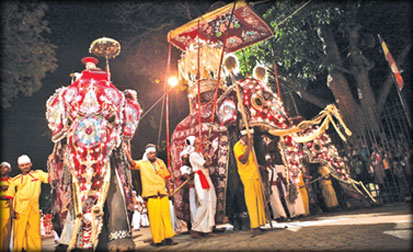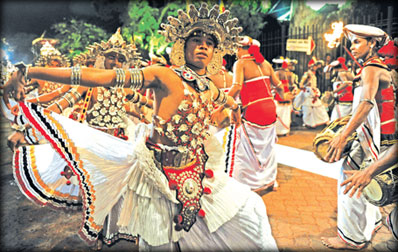Kandy Esala perahera, the pageant of pageants
By Kalakeerthi Edwin Ariyadasa
“In the ninth year of this King (Sirimeghavanna), a Brahman woman
brought hither (to Anuradhapura) from Kalinga country, the Tooth Relic
of the Great Sage Buddha.
The ruler received it with reverence, paid it highest honours, laid
it in an urn of pure crystal.... and brought it... to the Temple of the
Tooth Relic. The King spent 900,000 (Kahapanas) and arranged a great
festival for the Tooth Relic and decreed it should be brought every
year...
- Culavamsa Part I (CH. 37:92-97).
 Some years ago, a German Professor said: “Children need not only
food, drinks and clothes, but ‘Songs and rose’ as well.” This is true of
the masses too. Some years ago, a German Professor said: “Children need not only
food, drinks and clothes, but ‘Songs and rose’ as well.” This is true of
the masses too.
Over and above, severe, austere and harsh religious practices, people
yearn for pageants and spectacles.
In many spiritual traditions of man, celebrations and festivities
play a centrally important role. That explains why all faiths and creeds
of the world introduce, whenever and wherever feasible touch an
aesthetic touch.
Sri Lanka has a far-plung fame, for its dazzling and resplendent
religious pageantry. In this season, Esala - Sri Lanka celebrates a
whole series of pageants and parades, going along with a traditionally
set down religious agenda.
Many temples and devales have their annual pageants mostly at this
time of the year. Some of these are Buddhist in their spiritual essence.
Others are associated with the cult of various deities.
Greatest pageant
Of all these annual pageants of Sri Lanka, the widest renowned and
the grandest is of course the Esala procession of the Hill Kingdom -
popularly known as “Nuwara perahera”. It is Sri Lanka’s pageant of
pageants.”
Its well-documented origin can be traced back to a royal decree,
issued by a Sri Lankan monarch, about 1,600 years ago, promulgating that
an annual pageant be held in reverence to the Sacred Tooth Relic.
According to Sri Lanka’s national chronicle Culawamsa, this ruler,
King Srimeghavanna - spent 900,000 kabhapanas (gold coins) for the
original pageant, celebrating the Sacred Tooth Relic. Even from a
current view-point this is a vast and exorbitant sum of money.
Grandeur
One can very well imagine the scale of grandeur on which that
original Sacred Tooth Relic pageant was conducted.
In subsequent eras when the pageant of the Sacred Tooth Relic was
celebrated, the rulers of those times, would undoubtedly have attempted
to surpass the original glory of the Sacred Tooth Relic pageant.
With the exception of those dark days, when the continuity of the
indigenous rule eclipsed temporarily, interrupted by foreign invaders,
celebrating the Sacred Tooth Relic was a priority aspect of the Royal
rule.
The original Temple of the Sacred Tooth Relic in Kandy was built
under the patronage of King Wimaladhammasuriya I. This was about 415
years ago. It has undergone a whole series of changes and innovations.
The present Temple of the Sacred Tooth Relic is in reality the outcome
of age-old traditions which still illuminate the rites, rituals and the
main pageant.
The Nuwara perahera that the moderns view, has evolved over long
centuries enriched by continuing traditions. Some rites and rituals have
of course totally faded, yielding place to the new. In the early days,
for instance, the king himself took the first portion of the royal meal
to the Temple of the Sacred Tooth Relic, to offer it as he mid-day alms
of the Buddha. The King took the royal food to the temple in a Golden
container (Hema kada). The practice is not longer continued, but the
“Golden container” is among the items on display at the Sacred Tooth
Relic Museum.
When the annual pageant is held today - enhanced and modernised
through the utilisation of state-of-the-art technologies - the light
shed by the historical past is still present.
Casket
The gaily caparisoned elephants, sacred casket, torches of
traditional design, are all part of the light that illuminated the
pageant for thousands of years. Most of the rituals held daily at the
Temple of the Sacred Tooth Relic, still adhere to the traditional
practices, to the minutest detail.
Given this background, you can assure yourself that when you witness
the Nuwara Perahera, making its way along the streets of Kandy, you are
getting a glimpse into the distant past.
The majestic gait of the elephants that seem quite conscious of the
sacred duty they perform impresses you as much as it did, the citizens
of ancient Anuradhapura who stood in awe, watching the first Perahera,
held about 1,600 years ago.
The Diyawadana Nilame who walks along in dignified steps, symbolising
the spiritual loftiness of the occasion is the contemporary symbol of
the ancient King Sirimeghavanna and Prince Danta and Princess Hemamala,
who too would have invariably marched along in the original Perahera.
 The local and foreign visitors, through the streets, as the perahera
wends its way gloriously. The eager tourist adds an exotic feel to the
sacred pageant. The local and foreign visitors, through the streets, as the perahera
wends its way gloriously. The eager tourist adds an exotic feel to the
sacred pageant.
The traditional dancers whose ancestors too must have participated in
the pageant make it quite clear that this is an age-old cult that
achieves miraculous renewal each year. The glorious past lights up the
present.
The elaborate and complex hierarchy of officials who ensure the
proper performance of the rites and rituals echoes the past by
continuing practices that have traversed centuries.
Tradition
Some of them provide evidence of the persistence of the material
aspect of this great pageant. But there is a continuing spiritual
tradition as well. Millions of people in this land cherish a limitless
deference towards the Sacred Tooth Relic. A feeling of awe, generated by
their belief in the miraculous efficacy of the Sacred Tooth Relic
resonates within the rhythm of folk life.
When you are absorbed in the glorious and sublime pageant that is
passing in front of you, it is not at all likely that you will become
fully aware of the colourful history which moves before your eyes
establishing its power to renew itself year after year.
The throbbing of the drum tattoos the alluring steps of the dance
troupes, the swaying of the heads of the Perahera elephants, the
dignitaries clad in traditional costumes are sights and sounds that
enthral you in a hypnotic trance.
But when you recall the experience in your quieter moments, you will
be startled by the thought that all this has been lit up by a history
that spans long centuries. It will be then that the total meaning of the
pageant will register in your mind with a transforming impact. |


